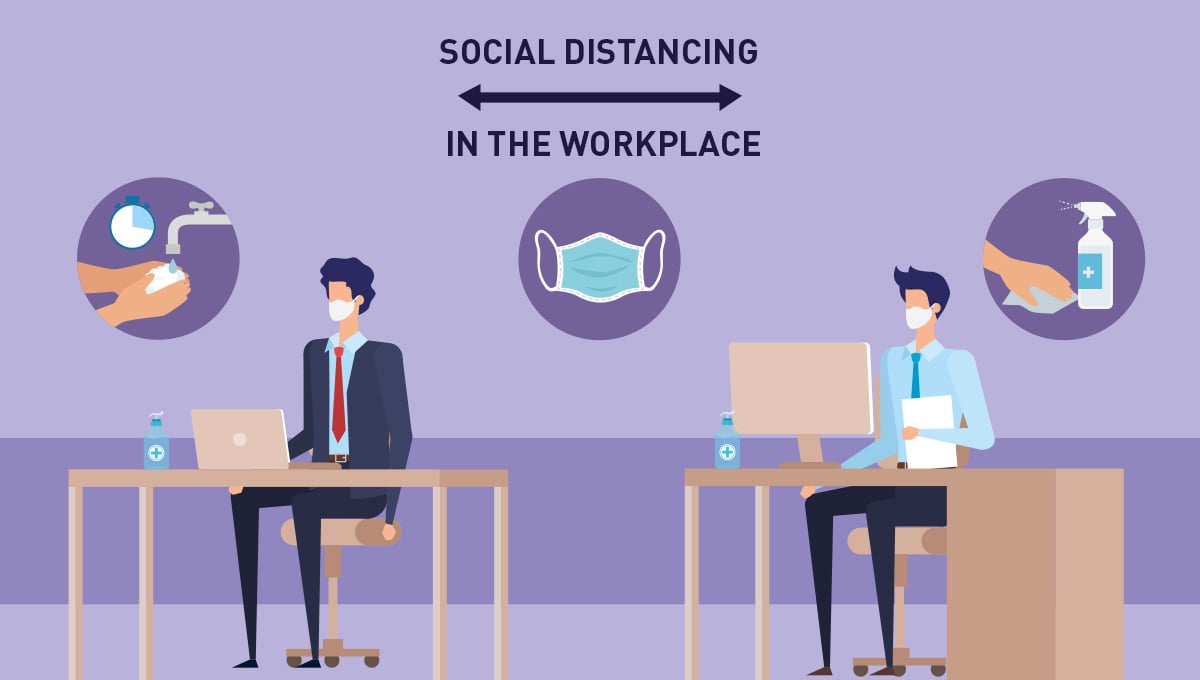
How the COVID-19 crisis will end is still uncertain. We are all learning how to co-exist with it and follow safety measures. Many of us are in the return phase, where we will learn to experience a new level in the new normal.
While each organization plans its return to the workplace, it is crucial to know how we can best implement preventive measures. Every organization will have unique needs, but the essentials of social distancing will apply to everyone.
As the virus is likely to spread through social contact keeping 6 feet distance away from any other symptomatic or asymptomatic person can avoid the spread of the virus.
Here are five best practices that will help your people succeed at social distancing.
Attendance and Crowd Control
Set up virtual meetings with your managers and colleagues to plan attendance and control your occupancy. Understand who needs to return to work during each phase of the return-to-work plan.
Collect employee feedback to understand how comfortable they are with returning to work. Start with standard self-screening procedures:
- Their health conditions. The Johns Hopkins center has an excellent online symptom checker.
- The health of their family members.
- Recent travel history.
Inform your employees about this beforehand so they can prepare.
Organize virtual meetings even when all your staff is in the workplace. If there is a need for a live face-to-face meeting, plan it in a large room where each of you can keep 3-6 feet distance from each other.
Staggered shifts and limiting your visitor policy only to those that are most critical can help reduce exposure to infection.
Have a team monitor all your attendance and occupancy practices.
PPE Policy
A Personal Protective Equipment policy can reduce exposure to infection or infectious persons, places, or surfaces. This policy involves equipping your staff with masks, gloves, goggles, gowns, safety helmets, respirators, and shoe covers.
Analyze your employees’ vulnerability to infection while interacting with customers or outsiders and provide them with the necessary PPE.
Some of the things you need to be mindful of are:
- Make sure you have sufficient PPE available in your inventory.
- Communicate your employees on the frequency of cleaning and washing practices for PPE.
- Regular monitoring of the proper use of PPE is a must.
Workspace Modeling
Office and workspace modeling are one of the vital parts of implementing social distancing. Here are some of the ways you can model your workplace to make sure all your employees stay safe at work:
- Make health screening mandatory at every entrance and ensure each of your staff carry their PPE.
- Set up desks with 3 - 6 feet distance in between each other.
- Make sure the number of people occupying a shared desk is limited to 3 or 4.
- Let your people work in staggered shifts, a few at a time, with consistent cleaning of the workspace between changes.
- Build a booking policy for face to face meeting rooms and make sure the rooms are large enough to practice social distancing.
As a part of workspace modeling, you should also have a clear-cut plan on workspace cleaning.
Clean. Clean. Clean to Disinfect
Frequent cleaning of surfaces that are touched by individuals touch must be a mandatory practice to prevent the spread of the virus. US DHS has an online calculator you can use to estimate how long the virus remains viable on various surfaces.
You need to decide on a cleaning and disinfecting protocol which should involve:
- Communication with your cleaning staff on your restructured cleaning and disinfecting plan.
- A regular cleaning schedule before and after working hours.
- The consistent sanitizing procedure of office spaces
- A plan for emergency cleaning if someone tests positive.
- An area-wise cleaning plan, including who should be responsible for cleaning each area.
- Who would administer office cleaning and disinfecting tasks and activities?
- Specific areas more frequented by staff need additional attention.
- The products your crew need to use to clean, disinfect, and sanitize.
Monitor travel, such as using public transport that can increase the risk of exposure. Ensure your people use safe commuting while coming to and leaving your workplace.
Commuting
Speak with all your people to understand their challenges concerning commuting to the workplace. If any of your staff is not sure of their commuting plan, give them some time to plan and get back to you. Consider approving those who request more time to work from home.
Reduce the shuttle capacity to 2 - 3, depending upon the vehicle.
Breaks and Lunch
Communicate with your staff about avoiding taking breaks together. Monitor cafeteria visits and lunch time to make sure everyone is following social distancing rules. You can also allow your people to have their lunch at their desks, which can help you avoid social interaction and food sharing.
Social Distancing for Safe Living
Returning to work in such uncertainty can be too risky where you are handling the entire responsibility of your people. It might need additional efforts from the leadership and team, so you can plan and implement return to work in the safest way possible.
Consistent communication with all your staff and supervision across your office and workspaces alone can keep you and your team safe.
We hope our inputs on social distancing helped you to kick start a safe Return to Workplace program.
Phenom eCloud is a comprehensive technology solutions provider committed to empowering businesses to overcome challenges, enhance their workforce capabilities, and achieve superior outcomes.




Leave a Comment